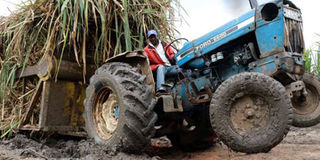Agency to inspect weighbridges to address cane farmers cries

A tractor transporting sugarcane struggles to pass through a muddy road at Miwani area in Kisumu County on August 14, 2016. Most of the weighbridges are rarely serviced or calibrated by the Weights and Measures Department to authenticate their accuracy. PHOTO | TONNY OMONDI | NATION MEDIA GROUP
What you need to know:
- To curb the vice, the Sugar Directorate says it is planning impromptu inspections at millers’ weighbridges following an outcry from farmers.
- In many instances, the farmer is not given a chance to go to the weighbridge to verify the weight of their cane.
Sugar farmers have been losing their produce through manipulation of weighbridge readings where the recorded tonnage is far below that delivered.
To curb the vice, the Sugar Directorate says it is planning impromptu inspections at millers’ weighbridges following an outcry from farmers.
“We have received complaints from farmers and we shall be taking action to ensure these weighbridges give the correct readings,” said Mr Alfred Busolo, the director-general of the Agriculture Food Authority (Afa).
Most of the weighbridges are rarely serviced or calibrated by the Weights and Measures Department to authenticate their accuracy.
The problem, which is partly blamed on the government, started when the defunct Kenya Sugar Board (KSB) failed to implement laws that require a miller to weigh cane on the farm before it is taken to the factory.
The regulation was meant to curb losses from tractors spilling some of the cane en route to the factory. In some cases, pedestrians also stole the produce.
The law is contained in the now repealed Sugar Act 2003, which was never gazetted.
In many instances, the farmer is not given a chance to go to the weighbridge to verify the weight of their cane.
“At Mumias Sugar, staff are growing cane online. They then generate a delivery note and a statement and get paid,” claimed one farmer.
However, Mumias chief executive Johnston Eroll denied the allegations saying the system is automated, making it difficult to manipulate.
“The weighbridge is fully automated so there is no human intervention. The only way cane could disappear is in transit and that is the responsibility of the transporter,” said Mr Eroll.
CANE LOSSES
Mr James Sakwa, a farmer, argues that if one looks at the financial statements of Mumias, they will tell you that “we have many farmers growing cane” when in essence some have uprooted the crop.
“People have uprooted cane and Mumias is counting farmers who don’t exist any more,” said Mr Sakwa.
The farmers claimed that officials from Mumias used to visit farms and count the stacks of cane, say 20, but deliver only one under contract and generate delivery notes for the other 19 to be delivered as private cane.
Mumias ends up paying a non-existent farmer for 19 stacks of cane while the actual farmer loses out.
Mr Clement Lumbe, a farmer in Lunza sub-location, claims he took six stacks of cane to Mumias and one could not be accounted for.
“I followed up the matter but no one would tell me how it disappeared. I eventually gave up as I was wasting money on transport every day with no hope of recovering my cane,” said Mr Lumbe.
In the 2014/15 financial year, Mumias suspended 52 employees over the loss of an estimated Sh400 million following termination of cane supply contracts with farmers.
The employees, managers and supervisors in the agriculture department, were accused of causing the sugar miller losses by irregularly terminating the farmers’ contracts, making it difficult for the company to recover money owed by the growers who had been advanced loans.
Asked how at Mumias some farmers get no payment even after delivering their cane, Mr Eroll said: “It’s very simple, actually. It usually is the farmer’s fault. It almost will never be the company’s fault.”
“A DR (debit) is basically when a farmer takes inputs from the company and if the farmer doesn’t look after his cane and when the cost is recovered, his crop doesn’t cover the cost of the inputs,” he said.




